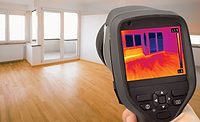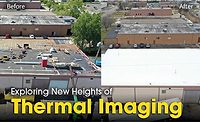The Evolution of Thermal Imaging Technology

Photos courtesy of Bloomfield Construction.

Photos courtesy of Bloomfield Construction.

Photos courtesy of Bloomfield Construction.

Photos courtesy of Bloomfield Construction.




The World Economic Forum says we are living in the Fourth Industrial Revolution. Today, there are more than 2.2 million apps in Apple’s App Store, and nearly three million in the Android store. A Time Magazine article published in early 2016 found at that time that 72 percent of Apple’s apps were aimed at toddlers and preschoolers. The WEF predicts 65 percent of the children in primary school today will “end up working in jobs that don’t even exist yet.” Our world is inundated with artificial intelligence, machine learning, robots, nanotechnology, smart systems in homes and factories, and other technological advancements that we could barely fathom even just one decade ago. According to Time, 10 years ago, the Pentagon had fewer than 50 drones. Early last year, that number was 7,000, and is likely exponentially higher today due simply to the rate of technological growth. Today, you can get a roof scope at the click of a button.
The restoration industry might not be as tech-driven as other industries around us; but all of us can likely admit technology is driving us to change how we do many things. It’s unlikely many of you are still using Excel spreadsheets for estimating, or faxing over multitudes of documents to carriers. It’s no longer necessary to start putting holes in walls and ripping out drywall to find moisture problems. And it becomes less and less necessary to repeatedly climb on roofs to assess damage as satellite and drone technology become more readily available to the masses.
Thermal imaging is one tool that has seen much more widespread adoption industry-wide in recent years. In R&R’s 2017 State of the Industry study, 76 percent of contractors said they use thermal imaging/infrared cameras. Likewise, almost 30 percent said they plan to purchase more IR cameras in the next 12 months. Gone are the days when this type of technology cost the same as a new ultrasonic machine. They are more readily available, and the capabilities have evolved. Today, there are drones on the market equipped with infrared cameras.
John Anderson, the Building & HVAC Business Development Manager for FLIR, said they haven’t seen a whole lot of drone usage for disaster applications just yet, but we are trending in that direction.
“We do see a lot of drone-based IR use for building inspection and roof inspection for water and energy issues,” he said. “For example, a drone-based IR camera can identify trapped moisture in commercial flat roofs in a few minutes, and inspect a few hundred thousand square feet in minutes.”
Leveraging the Weather
A Michigan contractor who specializes in both roofing and restoration jumped on the opportunity to get this technology, and said even without a drone, IR cameras play a big role in the restoration process at his company. Winter is an especially critical time to have crews with IR capabilities.
“The time of year matters,” explained Jeff Petrucci, owner of Bloomfield Construction. “If it rains in the summer, and I’m there two days later, the water in the wall could be the temperature as the room. Whereas in the winter, it’s easier to see the temperature difference where there is an ice dam or other water-related problem.”
“Contractors need to understand how to best leverage weather to their advantage for IR inspections,” Anderson agreed. “The best scans happen when the weather conditions are transitioning from warm to cold or cold to warm.”
Anderson went on to explain that trapped moisture holds heat and changes very slowly compared to other materials. When the air temperature drops in the evening or the sun starts to set, the building materials cool very quickly. Trapped moisture holds the heat for hours and becomes “visible” as the heat transfer process moves from the water to the surrounding areas.
“Even our residential sales reps carry IR cameras to sell jobs,” Petrucci said. During that initial meeting with a homeowner, moisture problems might be found that aren’t yet visible to the naked eye through symptoms like discolored drywall or mold. Contractors can even take it a step further with the IR cameras, and offer energy audit-type services to point out energy efficiency problems like cold air leaks around doors or windows, or areas where insulation might be missing. For Petrucci, the investment in the technology has more than paid for itself – and the devices are built to last. Plus, images from a thermal imaging device are bulletproof evidence for the adjuster and insurance company that there is a problem at a customer’s home that needs to be resolved.
What Thermal Imaging is Not…
It’s key to remember thermal imaging cameras aren’t giving you moisture readings, like a moisture meter. Instead, they show you a difference in temperatures. Experienced remediators learn, over time, what those differences mean – and are very easily able to pinpoint moisture problems just minutes after arriving at a customer’s home. Thankfully, this knowledge helps skilled contractors avoid the “hunt and peck” method, as Anderson put it, with moisture meters.
Anderson noted one common misconception is that IR technology is like x-ray vision. It is not. These cameras cannot see through the surface of materials; you can’t see through clothing, glass, etc. Again, it’s showing a difference in surface temperature.
Today’s Technology
Just like most technological innovations, IR cameras have evolved quite a bit. Anderson noted that price points on thermal imaging devices have come down in recent years. Plus, some now have moisture meters built in, “allowing the user to visually identify potential areas with IR and then immediately measure the moisture level with the meter.”
For FLIR devices, that technology is calling Infrared Guided Measurement, or IGM. Plus, through the download of an app you can turn your mobile device into a thermal imaging camera, although it should be noted you likely won’t get the same quality readings you would get from a standalone unit.
If you’re thinking about investing in a drone, Anderson does have some tips:
- There are FAA regulations for operating a drone for commercial use. Contractors need to get a Remote Pilot Certificate under the Part 107 guidelines.
- Contractors need to understand the material characteristics of the inspection. For example, an IR inspection for moisture is very difficult for an untrained user on steep-slope roofs with composite or tile roofing materials.
- Be ready for your inspections to go much faster!
Looking for a reprint of this article?
From high-res PDFs to custom plaques, order your copy today!











